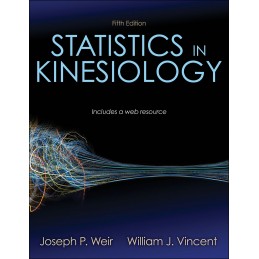Statistics in Kinesiology, Fifth Edition With Web Resource, offers students in kinesiology and exercise science programs a unique introduction to the statistics concepts and techniques relevant to their specific field of study. Drawing from examples across kinesiology, including exercise physiology, biomechanics, physical education, and physical therapy, this essential text provides students with a statistical skill set that will enable them to analyze quantitative data and find answers to questions they will encounter in their specific disciplines.
As in previous editions, emphasis is placed on methods commonly seen in kinesiology, such as correlation and bivariate regression, t tests, analysis of variance (ANOVA), and the interpretation of interactions in factorial analyses of variance. The fifth edition also incorporates fully updated content reflecting the changing face of kinesiology::
- Comparisons of observational versus experimental research and nonparametric versus parametric methods of analyzing categorical and ordinal data
- More detailed coverage on how to calculate central tendency when data have been transformed (e.g., log transformations) as well as multiple ways to interpret the correlation coefficient
- Expanded coverage of statistical graphs, including dot plots and spaghetti plots
- A discussion of the real meaning of p values and confidence intervals
- An introduction to frequentist approaches versus Bayesian methods
In addition, a new web resource offers abridged presentations of complex statistical concepts and an interactive platform to practice problem solving. Mini lectures, consisting of narrated slideshows, provide further explanations and may be quickly accessed through QR codes placed at the end of each chapter. Sample problems then provide an opportunity for students to put the concepts into practice.
Statistical software tools commonly used in kinesiology applications—such as JASP and G*Power—are briefly introduced, encouraging students to apply their knowledge of statistical procedures to generate and interpret computer results with confidence and ease.
With
Statistics in Kinesiology, Fifth Edition, students will gain a solid understanding of the statistical techniques used in physical activity fields. The books practical approach, based on the authors more than 50 years of combined experience in teaching statistics, will make it easy for students to learn these important, but often intimidating, concepts.


 Dostawa
Dostawa
 Płatność
Płatność
 Zwroty
Zwroty
